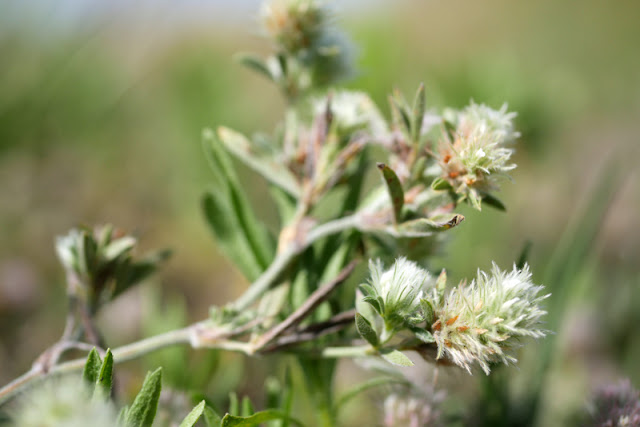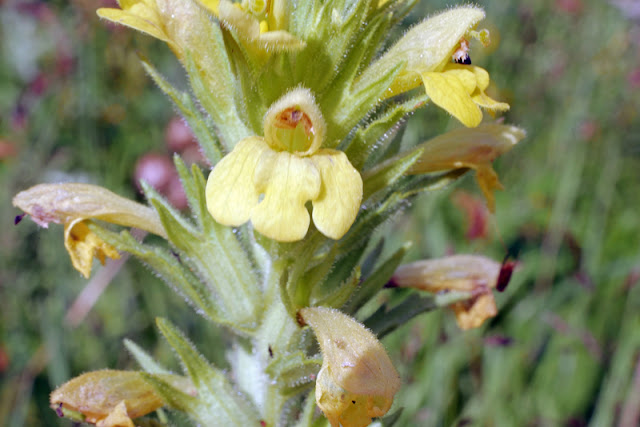Sandwich Bay, Kent - 18/08/20
This venue on the east coast of Kent is at its best in early Summer, with several very rare plant species to be found there, along with the largest Lizard Orchid colony in the UK. However, it was now mid July with Summer well and truly arrived with the earlier species mentioned all now died off, so it would be interesting to see what I might find.
I hoped to find Yellow Bartsia, having failed to find it at several other Kent sites this year. Records showed it present here in the past.
As I set off, I noticed that the Sea Holly was now in flower. It is common here and present all along the shingle where it starts to join with some topsoil.
Eryngium maritimum
Large stands of the yellow flowered Wild Fennel brightened up the upper beach and road areas. The first photo below shows its fine feathery leaves which seperates it from Wild Parsnip which has very similar (and same coloured) flowers. Of course, in case you forget you can crush a leaf of either plant and it will either smell of Fennel or Parsnip in any case! Identification solved.
Foeniculum vulgare
Most of the clovers had by now been burnt off by the Summer sun, but Haresfoot Clover was still flowering here and there.
Trifolium arvense
I then came to a fairly recently made large pond which looked natural but satellite images showed it's only been there about 20 years or so. It was all but dried up , but I had a look around hoping for something rare like Lesser Water Plantain.
I didn't find any of that, but its common relative Common Water-Plantain was present in good numbers.
This is usually a tall spindly plant with many small 3 petalled flowers, however the flowers are small, so if I photographed the whole plant, the flowers would be tiny specks. Note the basal leaves when you see it. Large spreading leaves and it will be this plant.
Alisma plantago-aquatica
From here I came to some grassland on a public footpath. One couldn't fail to see the brightly coloured orchids flowering there in profusion. First up were the beautifully coloured Southern Marsh Orchids, present in several locations here. They were just past their best but still a delight to see.
Dactylorhiza praetermissa

Amongst them were some beautiful Pyramidal Orchids too. White forms are present here, though I didn't spot any on this walk.
Anacamptis pyramidalis
Tucked away off the path in a damp dune slack were some Marsh Helleborines. I was pleased to find these as they were in a different area to where normally seen and a few were still in flower.
Some very ragged Ragged Robin completed the photos from this area.
Silene flos-cuculi
I walked past this area to where I had seen records of Yellow Bartsia. I was dismayed to find hundreds of Yellow Rattle in flower here. Having the same coloured flowers and being about the same height made it difficult to see my target species. However, I rounded a corner and there they were! I needn't have worried as they were actually much taller than the Rattle plants and the flowers substantially different too.
When I checked the database for this species, it turns out this location was that of the first ever sighting of this plant in the wild in Kent, back in 1960. Finder was the famous botanist, Francis Rose. This plant is still here and doing very well. My suspicion is that they arrived (accidentally or deliberately) with seeds of Yellow Rattle that would have been introduced to assist the orchids compete with grasses. Both Yellow Bartsia and Yellow Rattle are semi parasitic on other plants, usually grasses, thus allowing a greater bio diversity of that site.
Parentucellia viscosa
So ended an amazing day out botanising at Sandwich, a venue that always has something to offer. It seems so long ago now, but I hope this blog gives you a reminder of long Summer days.
Take care
Dave
@Barbus59





















Comments
Post a Comment
Comments welcome from those interested in my articles. For spammers don't bother as I moderate all comments prior to posting them.